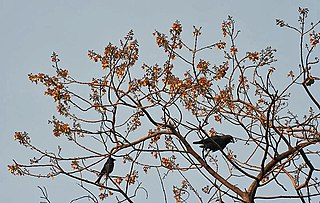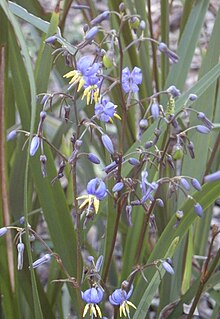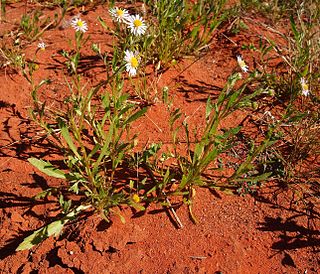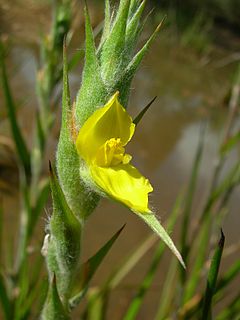
Vigna is a genus of flowering plants in the legume family, Fabaceae, with a pantropical distribution. It includes some well-known cultivated species, including many types of beans. Some are former members of the genus Phaseolus. According to Hortus Third, Vigna differs from Phaseolus in biochemistry and pollen structure, and in details of the style and stipules.

Elaeagnus, silverberry or oleaster, is a genus of about 50–70 species of flowering plants in the family Elaeagnaceae.

Eriocaulon is a genus of about 400 species commonly known as pipeworts, of monocotyledonous flowering plants in the family Eriocaulaceae. The genus is widely distributed, with the centers of diversity for the group occurring in tropical regions, particularly southern Asia and the Americas. A few species extend to temperate regions, with ca. 10 species in the United States, mostly in the southern states from California to Florida, and only two species in Canada; China has 35 species, also mostly southern. Only one species occurs in Europe, where it is confined to the Atlantic Ocean coasts of Scotland and Ireland; this species also occurs in eastern North America and is thought to be a relatively recent natural colonist in Europe. In the Americas, Eriocaulon is the only genus in its family that occurs north of Florida. They tend to be associated with wet soils, many growing in shallow water, in wetlands, or in wet savannas like flatwoods. In wet soils, their abundance appears to be related to water levels, fire frequency, and competition from other plants such as grasses. Experiments have shown that they are weak competitors compared to many other wetland plant species. Some species can persist as buried seeds during unfavorable conditions. The scientific name is derived from Ancient Greek εριον, erion, meaning 'wool', and καυλός, caulos, meaning 'stalk'.

Harpullia is a genus of about 27 species of small to medium-sized rainforest trees from the family Sapindaceae. They have a wide distribution ranging from India eastwards through Malesia, Papuasia and Australasia to the Pacific Islands. They grow naturally usually in or on the margins of rainforests or associated vegetation.

Jagera is a genus of 4 species of forest trees known to science, constituting part of the plant family Sapindaceae.

Exocarpos is a genus of flowering shrubs and small trees in the sandalwood family, Santalaceae. They are found throughout Southeast Asia, Australia and the Pacific Islands.

Gmelina is a genus of plants in the family Lamiaceae. It consists of about 35 species in Australia, New Guinea, New Caledonia, Southeast Asia, India and a few in Africa. Some species such as G. arborea have been planted and/or become naturalised in India, Africa and Australia. It was named by Carl Linnaeus in honour of botanist Johann Georg Gmelin.

Helicia is a genus of 110 species of trees and shrubs, constituting part of the plant family Proteaceae. They grow naturally in rainforests throughout tropical South and Southeast Asia, including India, Sri Lanka, Indochina, Peninsular Malaysia to New Guinea and as far south as New South Wales.

Dianella caerulea, commonly known as the blue flax-lily, blueberry lily, or paroo lily, is a perennial herb of the family Asphodelaceae, subfamily Hemerocallidoideae, found across the eastern states of Australia and Tasmania. It is a herbaceous strappy perennial plant to a metre high, with dark green blade-like leaves to 70 cm long. Blue flowers in spring and summer are followed by indigo-coloured berries. It adapts readily to cultivation and is commonly seen in Australian gardens and amenities plantings.

Lepidosperma is a genus of flowering plant of the family Cyperaceae. Most of the species are endemic to Australia, with others native to southern China, southeast Asia, New Guinea, New Caledonia and New Zealand.

Stackhousia is a genus of annual and perennial plants in the family Celastraceae that are native to Australia, New Zealand, Malesia and Micronesia. The genus was first described by James Edward Smith in Transactions of the Linnean Society of London in 1798.

Burchardia is a genus of herbs that are endemic to Australia. The genus is named for Johann Heinrich Burkhardt, a German botanist.

Vittadinia is a genus of Australian and New Zealand plants in the aster tribe within the daisy family.

Randia moorei, commonly known as the spiny gardenia, is a rare Australian shrub growing in the far north eastern areas of the state of New South Wales and adjacent areas in Queensland. The habitat is subtropical rainforest north of Lismore.

Grevillea oxyantha is a plant from the Protea family, found in the cold mountain regions of southern New South Wales, Australia. The species grows from one to three metres in height. They are often found on rocky places, near cliffs or occasionally near streams. Rock types are mostly granite or quartzite. Nearby localities include Wee Jasper, Tumut, Batlow and Brown Mountain.

Philydrum is a genus of tufted, herbaceous, aquatic macrophyte plants, one of three genera constituting the plant family Philydraceae.

Syzygium fullagarii, commonly known as the scalybark, is a relatively large tree in the Myrtle family. It is found only on Lord Howe Island. It grows to 20 metres tall, up to an altitude of 400 metres above sea level in sheltered areas, often in rainforest. The bark is reddish brown, usually flaking to the touch. The base of the tree is often heavily buttressed. Known for many years as Cleistocalyx fullagarii, however, in recent times it has been placed in the large genus Syzygium.
Grevillea glauca, commonly known as bushman's clothes peg, cobblers peg tree or the beefwood tree, is a shrub or small tree that is native to Papua New Guinea and north-eastern Queensland, Australia. It usually grows to a height of between 2 and 10 metres and has leaves that are 6 to 20 cm long and 1 to 6.5 cm wide. Flowers are cream or greenish white and appear between April and August in the species' native range. These are followed by rounded follicles that are 2.4 to 4 cm long.

The National Herbarium of New South Wales was established in 1853. The Herbarium has a collection of more than 1.4 million plant specimens, making it the second largest collection of pressed, dried plant specimens in Australia, including scientific and historically significant collections and samples of Australian flora gathered by Joseph Banks and Daniel Solander during the voyage of HMS Endeavour in 1770.

Brachyscome ascendens, the border ranges daisy, is a species of flowering plant in the family Asteraceae and is endemic to Australia. It has mostly mauve daisy-like flowers and a yellow centre.


















